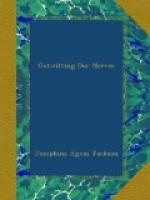That the conscious mind has no part in the subterfuge is shown by the fact that both patients gave up their artificial haven as soon as they saw how they had been fooling themselves. The fact remains that every neurosis is the fulfilment of a wish,—a distorted, unrecognized, unsatisfactory fulfilment to be sure, but still an effort to satisfy desire. As Frink remarks, “A neurosis is a kind of behaviour.” We always choose the conduct we like. It is a matter of choice. Does not this answer our question as to why some people always take unhealthy suggestions? If we take the bad one, it is because it serves the need of a part of our being.
SIGN LANGUAGE
=Talking in Symbols.= We have several times suggested that a nervous symptom is a disguised, indirect expression of subconscious impulses. It is the completeness of the disguise which makes it so hard for us to realize its true meaning. It takes a stretch of the imagination to believe that a pain in the body can mean a pain in the soul, or that a fear of contamination can signify a desire to bear a child. But in all this we must not forget the primitive, childlike nature of the instinctive life.
The savage and the child do not think as civilized man thinks. Savage or child thinks in pictures; he acts his feelings; he groups things according to superficial resemblances, he expresses an idea by its opposite; he talks in symbols. We still use these devices in poetic speech and in everyday thought. A wedding-ring stands for the marriage bond; the flag for a nation; a greyhound for fleetness; a wild beast for ferocity; sunrise for youth; and sunset for old age. “The essence of language consists in the statement of resemblance. The expression of human thought is an expression of association."[40]
[Footnote 40: Trigant Burrow: Journal of American Medical Association, Vol. LXVI, No. II, 1916.]
The association may be so accidental and superficial as to seem absurd to another person, or it may be so fundamental as to express the universal thought of man from the beginning of time. Many of the signs and symbols which crop out in neurotic symptoms and in normal dreams are the same as those which appear in myths, fairy tales and folk-lore and in the art of the earlier races.
=A Secret Code.= When the denied instincts of a man’s repressed life insist on expression, and when the shocked proprieties of his repressing life demand conformity to social standards, the subconscious, held back from free speech, strikes a compromise by making use of figurative language. As Trigant Burrow says, if the moral repugnance is very strong, the disguise must be more elaborate, the symbols more far-fetched. The symbols of nervous symptoms and of dreams are a “secret code,” understood by the sender but meaningless to the censoring conscience, which passes them as harmless.




